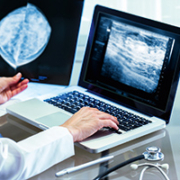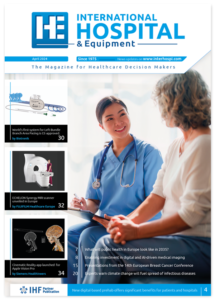Digital breast tomosynthesis – evidence of superiority versus mammography, but more research needed
Digital tomosynthesis creates a three-dimensional (3-D) picture using X-rays. In this respect, tomosynthesis is close to a CT (computed tomography) scan. Nevertheless, there are differences between the two. In fact, the development of CT is considered to be one of the reasons for a decline in interest in tomosynthesis, until recently.
One of the principal applications for tomosynthesis today is breast cancer. The basic difference between a digital breast tomosynthesis (DBT) and conventional mammography lies in detail. DBT removes confusing overlying tissue, thus providing clearer imaging and clarity. It also has improved low contrast visibility over mammography, even at a reduced dose. Some explain the difference between DBT and mammography as that of a ball compared to a circle. Nevertheless, in spite of its higher accuracy, the X-ray dose for DBT is similar to that of a mammogram.
Tomosynthesis and CT
Tomosynthesis is now increasingly seen as a low-dose alternative to CT, and is being evaluated against both CT and radiography in several areas, such as erosion in arthritis, or fractures accompanied by metal artifacts.
Technically, tomosynthesis combines digital image capture with the tube/detector motion of CT. However, there are several differences. In CT, the detector makes at least one complete 180-degree (half circle) rotation around the subject. Images are then reconstructed from this data. Tomosynthesis uses a far smaller rotation angle and a lower number of discrete exposures than CT. The lack of comprehensiveness in projections, compared to CT, is compensated by digital processing – with reconstruction of slices at varying depths and thicknesses. The result is that the images are similar to CT, but have a lower depth of field. The reduction in projections, as compared to CT, cuts down on both radiation dosage and cost.
Mammography : the approaches
A mammogram is basically an X-ray examination. However, it uses a machine designed specifically for examining breast tissue. The X-ray format in a mammogram is different while radiation dosages are lower than a conventional X-ray. One of the problems with the latter is that X-rays do not easily penetrate breast tissue. In a mammogram, two glass plates compress the breast to spread out the tissue allowing for a better and more accurate image, using less radiation.
Mammography, formally known as full-field digital mammography (FFDM), usually takes two X-rays of the breast from above (cranial-caudal view, CC) and from an oblique or angled view (mediolateral-oblique, MLO). Single-view mammography uses only the MLO view, and was widespread in the early days of screening. However, it has lower sensitivity and higher recall rates, compared to two-view mammography. Theoretically, the only advantages of single-view mammography are less radiation (which is especially important for young women, who are more sensitive to radiation) and quicker examination speed.
Breast cancer and the mammogram
Breast cancer shows as a typically denser zone than adjacent healthy breast tissue in a mammogram, where it appears as an irregular white area or shadow’.
The term digital’ mammography sometimes confuses patients. However, it simply applies to the storage medium. While regular mammography provides film pictures, digital mammography records images on a computer.
The DBT procedure
While a mammogram is a modified X-ray machine, DBT is delivered by a modified mammogram. It positions the breast in the same way as a mammogram. However, the compression required is less than the latter, in effect just enough for preventing the breast from movement. The X-ray tube then moves around the breast in a circular arc, typically taking 11 X-ray images of 1 mm thickness from different angles, usually over 10 minutes. The images are synthesized by a computer into a clear and highly-focused 3-D image throughout the breast. This allows specialized breast radiologists to see clearly through layers of tissue, including dense tissue, and examine zones of concern from a full range of angles.
Patient comfort is a factor clearly favouring DBT. The breast compression required for a mammogram can be uncomfortable and even sometimes painful, deterring several women from getting tested.
The challenge of false negatives and positives
From a clinical perspective, the high degree of breast compression required by a mammogram can also result in causing folds and overlaps in breast tissue, which can hide the cancer. In other words, negative results do not a guarantee that a woman is cancer-free. The false negative rate is estimated to be as much as 15-20percent. It is also higher in younger women as well as in women with dense breasts.
On the other side, mammograms also face major challenges from false positives. A mammogram may show areas that are considered suspicious or abnormal. This is followed by additional tests (further mammograms, ultrasound and MRI, or an invasive breast biopsy).
One study, published in the May 2014 issue of Annals of Internal Medicine’ found that after 10 years of annual screening mammography, more than half of women will receive at least one false-positive recall.
Some estimates find that 75-80percent of all breast biopsies are unnecessary – that is, they do not find cancers, and 7-9percent receive a false-positive biopsy recommendation. In general, the higher effectiveness of DBT means that patients require fewer (unnecessary) biopsies or other tests.
DBT and multiple tumours
Tomosynthesis also has another major advantage. It has a far greater likelihood than mammography of detecting multiple tumours (which occur in about one in 7 breast cancer patients).
History of DBT
Massachusetts General Hospital (Mass General) in the US is generally credited with pioneering the development and implementation of DBT into a screening programme. In 1992, the hospital’s specialized breast imaging team began researching application of tomosynthesis. In March 2011, just one month after breast tomosynthesis was approved by the US Food and Drug Administration (FDA), Mass General announced that it had performed the first clinical DBT exam in the US. In 2014, the hospital adopted breast tomosynthesis plus mammography as standard protocol for all breast screening.
The hospital states that breast tomosynthesis research in large populations consistently shows ‘improved breast cancer detection rates, especially invasive cancers’ as well as a ‘decrease in call backs, which may lessen anxiety for patients.’
DBT not yet standard of care
Even though digital breast tomosynthesis is now FDA-approved for more than five years, it is not yet considered the standard of care for breast cancer screening. A 2009 recommendation from the US Preventive Services Task Force (USPSTF) has recently been updated. However, it observes that current evidence still remains insufficient to assess the benefits and harms of DBT as a primary screening methodology for breast cancer.
Nevertheless, DBT is available at a small but growing number of US hospitals. These are generally licensed and accredited by the FDA as well as the American College of Radiology (ACR).
DBT in Europe
In Europe, the European Reference Organisation for Quality Assured Breast Screening and Diagnostic Services (EUREF) has recently updated its breast tomosynthesis protocol (version 1.01). Key changes concern technique and methodology (back-projection, dosimetry etc.).
European breast cancer experts frequently cite US studies that show a significant decrease in recall rate using DBT as adjunct to mammography, as well as the increase in cancer detection rates.
Meanwhile, there have recently been several European trials on DBT.
STORM: DBT versus 2D mammograms
The results of one of the first European trials, known as Screening with Tomosynthesis OR standard Mammography (STORM), were published in 2013. This was a prospective comparative study conducted at the University Hospital of Trento, Italy. It sought to determine if DBT overcame some of the limitations of conventional 2D mammography for detection of breast cancer.
The findings were conclusive. The authors of the study estimated that conditional recall could have reduced false positive recalls by 17.2percent without missing any of the cancers detected in the study population.
DBT and mammography combinations studied in Norway
Combinations of DBT with reconstructed 2D images or standard (digital) mammography have also been investigated for screening in Norway.
The Norwegian study was led by a team at Oslo University Hospital, Ullevaal. It sought to compare the performance of two versions of reconstructed two-dimensional (2D) images in combination with DBT versus standard FFDM plus DBT.
Cancer detection rates over two different periods were 8.0 and 7.8 per 1,000 screening examinations for FFDM plus DBT, and 7.4 and 7.7 per 1,000 screenings for reconstructed 2D images plus DBT. False-positive scores were 5.3percent and 4.6percent (over the two periods for FFDM plus DBT, respectively), and 4.6percent and 4.5percent (for reconstructed 2D images plus DBT).
The conclusion of the Norwegian study, published in the June 2014 issue of Radiology’ was clear:
‘The combination of current reconstructed 2D images and DBT performed comparably to FFDM plus DBT and is adequate for routine clinical use when interpreting screening mammograms.’
Sweden: DBT versus mammography, and combinations
Meanwhile, a trial in Sweden, known as the Malmo Breast Tomosynthesis Screening Trial (MBTST), published its results in 2015. MBTST claims to be the first trial designed to assess the efficacy of one-view DBT versus two-view mammography in brast cancer screening, along with a combination of one-view DBT and one-view mammography versus two-view mammography. The authors, from the University of Lund’s Malmo campus found ‘a significant increase in cancer detection rate when using one-view DBT as a stand-alone screening modality, compared to two-view DM (digital mammography). The recall rate increased significantly but was still low.’ They concluded that one-view DBT might be feasible as a stand-alone breast cancer screening modality.
DBT and ultrasound
European researchers have also sought to go beyond comparing DBT with mammography alone. In March 2016, the European CanCer Organisation (ECCO) released interim results from a trial called ASTOUND (Adjunct Screening with Tomosynthesis or Ultrasound in Mammography-negative Dense breasts) at a conference in Amsterdam.
ASTOUND has been recruiting asymptomatic women who attend for breast screening at five imaging centres in Italy and who have extremely dense breasts (defined by the BI-RADS Breast Imaging and Reporting and Data System as being in Categories 3 and 4).
The researchers, led by Dr. Alberto Tagliafico, a radiologist and Assistant Professor of Human Anatomy at the University of Genoa, Italy, have found that adding either DBT or ultrasound scans to standard mammograms could detect breast cancers that would have been missed in women with dense breasts.
Outlook for the future
In general, whether in the US or Europe, more remains to be done to conclusively establish the advantages of DBT in screening. However, it is indisputable that DBT does results in a significant increase in cancer detection rates.
An article in the April 2016 edition of Breast Cancer’ by P. Skane (who led the Norwegian trial mentioned above) argues that ‘DBT should be regarded as a better mammogram that could improve or overcome limitations of the conventional mammography, and tomosynthesis might be considered as the new technique in the next future of breast cancer screening.’


